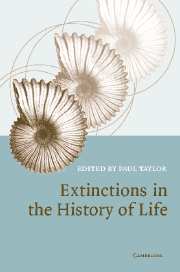Book contents
- Frontmatter
- Contents
- Notes on contributors
- Preface
- 1 Extinction and the fossil record
- 2 Extinctions in life's earliest history
- 3 Mass extinctions in plant evolution
- 4 The beginning of the Mesozoic: 70 million years of environmental stress and extinction
- 5 Causes of mass extinctions
- 6 The evolutionary role of mass extinctions: disaster, recovery and something in-between
- Glossary
- Index
Preface
Published online by Cambridge University Press: 18 December 2009
- Frontmatter
- Contents
- Notes on contributors
- Preface
- 1 Extinction and the fossil record
- 2 Extinctions in life's earliest history
- 3 Mass extinctions in plant evolution
- 4 The beginning of the Mesozoic: 70 million years of environmental stress and extinction
- 5 Causes of mass extinctions
- 6 The evolutionary role of mass extinctions: disaster, recovery and something in-between
- Glossary
- Index
Summary
Extinction is a corollary of life itself. Just as the death of individuals is assured, so the extinction of species can be pretty much guaranteed in the fullness of geological time. Indeed, a leading palaeontologist once famously quipped that to a first approximation life on Earth is extinct. By this he meant that the great majority of species ever to have lived on the planet are no longer with us. Today we are rightly concerned with the threat to the survival of many contemporary species, and we mourn the loss of those that have disappeared in historic times, more especially because their extinction was very often due to overexploitation or habitat destruction by humankind. While the extinctions occurring at the present day may be viewed as atypical and in some respects ‘unnatural’, taking a broader view across geological time extinction can be seen as a major constructive force in the evolution of life, removing incumbents and allowing other groups of animals and plants to prosper and diversify. A renaissance of interest in extinction has been ignited not only by the contemporary biodiversity crisis, but also by the development of analytical approaches to the fossil record and of new geological techniques that have greatly increased our appreciation of global change. Our understanding of extinctions in the history of life is far better now than it was a few decades ago.
- Type
- Chapter
- Information
- Extinctions in the History of Life , pp. xi - xiiPublisher: Cambridge University PressPrint publication year: 2004



